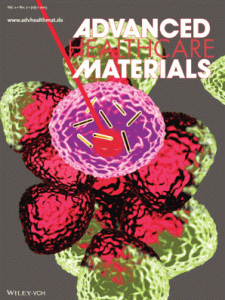Here are the top five papers downloaded in July 2013. For a limited time, you can also view the July issue of Advanced Healthcare Materials for free, without subscription.
Cellulose-Based Diagnostic Devices for Diagnosing Serotype-2 Dengue Fever in Human Serum by Hsi-Kai Wang, Cheng-Han Tsai, Kuan-Hung Chen, Chung-Tao Tang, Jiun-Shyang Leou, Pi-Chun Li, Yin-Liang Tang, Hsyue-Jen Hsieh, Han-Chung Wu and Chao-Min Cheng
Two types of cellulose-based in-vitro diagnostic devices for the diagnosis of dengue virus infection in both buffer system and human serum are demonstrated. This approach adheres to US FDA regulations, especially in regards to in-vitro diagnostic device performance evaluations with appropriate data analysis. This research could significantly advance a broad range of diagnostic developments.
Targeting Dendritic Cells: The Role of Specific Receptors in the Internalization of Polymer Capsules by Justine D. Mintern, Chiori Percival, Marloes M. J. Kamphuis, Wei Jin Chin, Frank Caruso and Angus P. R. Johnston
Dendritic cells are an important target for vaccine delivery. It is shown that antibody functionalized polymer capsules can effectively target dendritic cells; however, the internalization is highly dependent on the specific receptor targeted. This work highlights the importance of considering factors such as how the antibody/capsule is internalized, rather than just the target specificity.
Gold Nanoparticle-Loaded Neural Stem Cells for Photothermal Ablation of Cancer by Kenna Schnarr, Rachael Mooney, Yiming Weng, Donghong Zhao, Elizabeth Garcia, Brian Armstrong, Alexander J. Annala, Seung U. Kim, Karen S. Aboody and Jacob M. Berlin
Neural stem cells maintain their tumor tropism after internalizing gold nanorods. When exposed to a laser, the loaded cells heat up, destroying surrounding tumor cells.
Mechanically Robust, Negative-Swelling, Mussel-Inspired Tissue Adhesives by Devin G. Barrett, Grace G. Bushnell and Phillip B. Messersmith
Adhesive hydrogels that negatively swell at physiological temperature are presented. By combining mussel-mimetic chemistry and the thermosensitive nature of poly(ethylene oxide)-poly(propylene oxide) copolymers, novel materials are designed that are suitable as medical sealants and adhesives.
Engineering the Regenerative Microenvironment with Biomaterials by Jeffrey J. Rice, Mikaël M. Martino, Laura De Laporte, Federico Tortelli, Priscilla S. Briquez and Jeffrey A. Hubbell
Significant advancements in biomaterial engineering have been driven by our improved understanding of the regenerative microenvironment including the roles of growth factors and cytokines and their interactions with the extracellular matrix to control the healing response. Here, advanced hydrogel scaffolds that are engineered to enhance tissue healing and regeneration are reviewed.


















